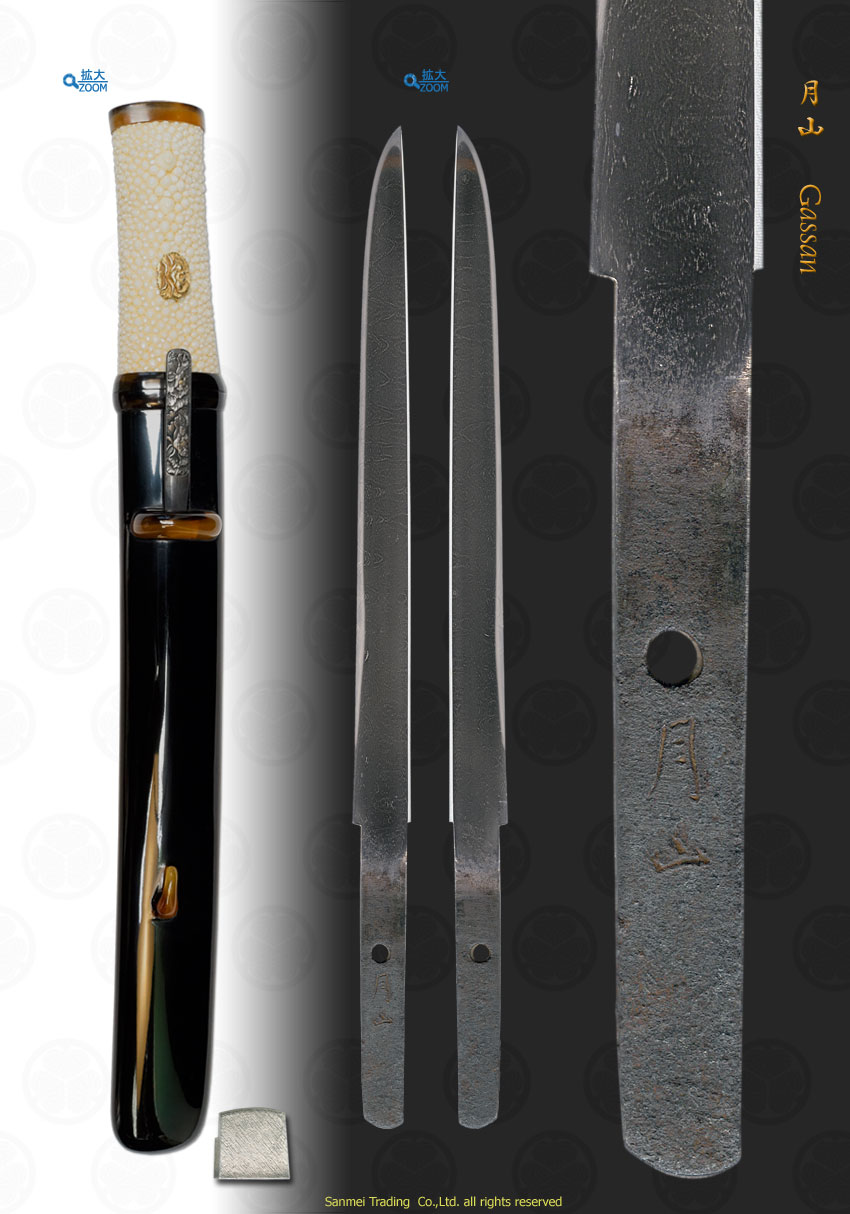with)Tortoiseshell work black lacquered sheath Aikuchi Tanto Fitting
Length of cutting edge 21.9cm Inward curvature Width of base 18.6mm Thickness of base 5.7mm
Forging(Hada): Forging is conspicuous AYASUGI (curved) in order. The surface shows moistened beauty of old elegance impression with fine Nie sparkling glitter and mottled Utsuri reflection in order to AYASUGI curve.
Temper(Hamon): Temper starts at 25mm upper the Hamachi "Yakiotoshi" fine Nie hard metal granules base, straight with shallow wave indication, mixed with precise Gunome and irregular shape. Temper edge is active with curved mark of Kinsuji threadlike area which is corresponds to AYASUGI curved Chikei forging marks against sparkling Nie granules. The interior of temper contains full of mist-like crystalline area to add frequent "Sunagashi" short lines of Nie brushing indication.
Temper of tip(Boshi): Temper of tip is strong hard metal granule base, straight with double or brushing indication and medium circle turns back.
Tang(Nakago): Nakago is in UBU original. Shallow slanting left file marks. One peg hole. Double-bevelled (Kurijiri) heel shape. Back ridge of Nakago is flat. The signature in front is two character that reads GASSAN 月山.
In 12th C., ancient sword makers in Oushu 奥州, another name for Mutsu Province of Northern area had developed since Heian period. Mogusa 舞草 or Houju 宝寿 lineage had prospered in Hiraizumi 平泉 area under the patronage of Northern Fujiwara noble family.
Ultimately they were conquered by the Kanto Samurai clans led by Minamoto no Yoritomo 源頼朝.
In Muromachi period, the GASSAN 月山 sword makers occurred under the patronage of Shugendo group 修験道 who had faith in Mt. GASSAN 月山. Their main workshops would be Sagae, Yamagata 寒河江・谷地. GASSAN lineage had been prospered mostly in Muromachi period but suddenly disappeared on after Sengoku period (end 16th C.).
GASSAN AYASUGI-established tradition had revived by Gassan SADAKATSU 月山貞勝 after two centuries in Settsu(Osaka) domain then matured by the famed smith Gassan SADAKAZU 月山貞一 and present day the 2nd generation of Gassan SADAKAZU 月山貞一 who is a holder of an important intangible cultural asset on Showa 46 (1971).
The subject Tanto "GASSAN", aged on about end 14th C.(Meitoku-Ouei), under the top quality Togi (polish) status, blimming over with AYASUGI(curved) forging marks and overflowed with rich quench activities such as sparkling Nie granules and thick lines or curved thread-like area that glitters in a misty-crystalline area. The shape is classical grace and quench starts upper the Hamachi (Yakiotoshi) that still shows the long-established tradition since 12th C.
The top quality mounting is AIKUCHI-style, with tortoiseshell work of kashira, Fuchi, Koikuchi, Kurikata, Ura-kawara, Kaeri-tsuno and Mekugi). Transparent amber against pure Roiro-style transparent black lacquer creates an atmosphere of "Wabi-Sabi" that is "Simple-Japan-beauty". White Ray-skin hilt work, even Mekugi peg is made of tortoiseshell, in top quality adds a pair of Peony flower carving Menuki ornament made of pure gold. A perfectly matching Kozuka/Kogai set which is made of pure silver is also Peony flower design delicately carved.
Recent polish by the top Mukansa awarded polisher/Condition scale: excellent (using a scale of mint-excellent-very good-good-fair-poor).
This GASSAN tanto gives you honor of rich activity scene that comes from traditional steel forging and quench technique plus enjoyment to possess the top quality Koshirae mounting.
Old silver foiled copper ground Habaki collar. Comes in Shirasaya mounting.
reference data:
Honma Junji/Satou Kanichi, NIHONTO TAIKAN KOTO-HEN 3 Otsuka Kogei sha, 1969
Honma Junji/Satou Kanichi, SHIN-NIHONTO KOUZA Yuzankaku, 1970

